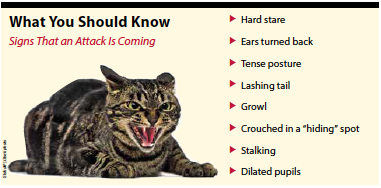Cats aren’t always friendly and cuddly. Whether it is your trusty cat having a bad day, a teenage kitten playing too rough, or a stray cat defending its territory, knowing the signs a cat might attack will help you avoid a bad bite.
“Cats may attack their owners for various reasons, including fear, irritability, pain, or to solicit play or attention,” says Pamela J. Perry, DVM, PhD, behavior resident at Cornell University’s College of Veterinary Medicine. “Some cats also redirect their aggression from their intended target, like an outdoor cat, to the owner.”
Aggressive Attacks
A cat who is attacking out of aggression is likely to bite—and hard. These cats are obvious with their body language if you know what to look for.
“An aggressive cat walks with his head slightly lowered and his back legs straightened so that the back slants downward from rump to head. His pupils may be constricted, and his ears are typically erect but rotated so that the openings are facing towards the back,” says Dr. Perry.
The overall impression of an aggressive cat is tightly wound—these cats are tense and stiff, not loose and relaxed. Their movements are sharp, maybe striking with a paw, with claws out, or lashing the tail back and forth quickly. That wagging tail is not friendly.
Aggressive cats may hiss, but they often growl. Feline growls are a sustained yowl, like a blender on high.
Signs of aggression can be quieter, too, especially in disputes between cats in the household. One cat may stare another down, particularly when blocking the other cat from accessing a resource such as food or prime perches. The aggressor or bully will be tense and upright, often oriented toward the other cat, while the victim will be hunched in on herself, leaning or looking away. If both cats are showing aggressive body language, a fight may be in store.
If a cat looks like it is going to attack you, get out of there. “Try to alleviate the situation by walking away/ignoring him or by distracting him. Some possible distractions include tossing a toy or empty plastic bottle near (not at!) him to redirect his focus or making a loud, strange sound,” says Dr. Perry. If possible, get a solid barrier between you and the aggressive cat. Never try to punish an aggressive cat. It will most likely make the situation worse.

Redirected Aggression
Not all cat attacks are truly about the victim. Instead, sometimes cats who are unable to attack the true source of their irritation turn on the nearest being.
A common scenario is when your cat sees another cat outside a window or sliding door. Your cat may not be thrilled about this trespasser and may try to threaten it. Being unable to get to the interloper leads to frustration. Depending how wound up your cat is, he might turn on you or another pet in the household if you wander too close.
Cats displaying redirected aggression will show the same behaviors as a truly aggressive cat, but the initial displays are oriented toward the source, i.e., a cat outside or a resource that the cat is trying to get but can’t access. The attack often comes when an unsuspecting victim either brushes against the angry cat or walks too close and startles them.
Do not touch your cat if she is showing signs of aggression, even if they aren’t directed at you. She could bite you by accident. Instead, redirect her with a toy or by making a loud noise to break her focus. Then plan how to prevent the situation from occurring again, such as putting up window clings to block your cat’s view or deterring strange cats from hanging out in your yard.
Play Attacks
“Stalking, chasing, pouncing, and biting are typically seen in kittens and young cats because they engage in play more frequently, but these also can be displayed by older cats,” says Dr. Perry.
Cats launching play attacks show slightly different behavior than truly aggressive cats. They usually hunker down in a “hiding” spot so they can jump out and launch a sneak attack. Popular spots include under coffee tables, behind curtains, or behind other furniture.
While cats plotting a play attack will be tense and focused, their body posture isn’t usually quite as stiff as an aggressive cat. The cat will crouch down to stalk, and the tail may wave back and forth, often with more curve to it than the lashing of an angry cat. These cats typically do not hiss or growl.
Even though your cat is playing, she could bite and break the skin. It is important to discourage these play attacks and provide your cat with appropriate outlets for her energy and hunting instincts. Play with her at least once a day, engaging her with toys to burn off some steam. Never wrestle with your cat with your hands, as this can encourage play biting.
Prevent access to her attack hiding spots, and toss toys ahead to lure her out if you think she is waiting for you.




